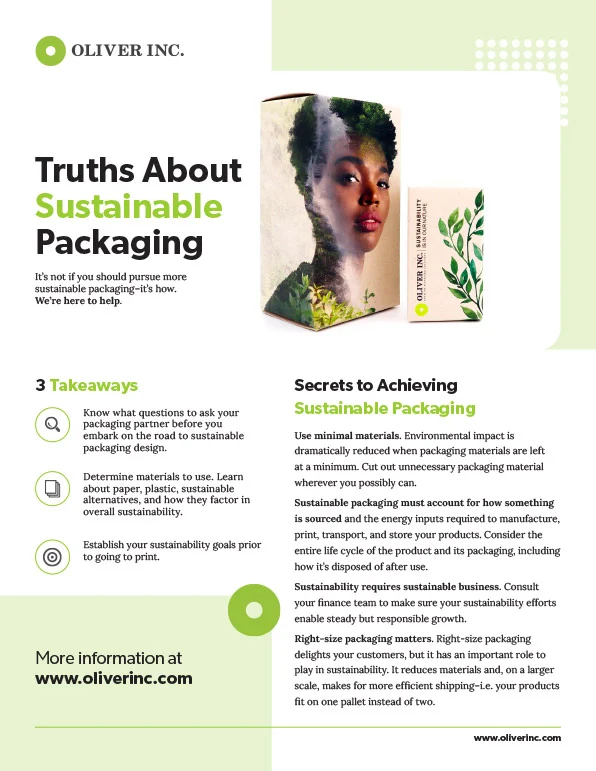How Sustainable Is Paperboard? What You Need to Know
Posted by Oliver Inc. on 26th Aug 2021
Consumers continue to push for more eco-friendly products from brands willing to take action on climate change. For those eager to make it easier for consumers to go green, choosing the right packaging materials is an important area of the business to examine.
Paperboard remains a common substrate for folding cartons, marketing collateral, and more. But how sustainable is it?
Sustainability of Paperboard
Paperboard is a substrate derived from trees. As such, it’s incredibly renewable, presuming the operations related to its production and distribution abide by sustainability principles and practices. This means there are many processes that determine its level of sustainability.
Sustainable packaging focuses on leaving a minimal environmental impact, but what does that look like? It’s about reducing the amount of packaging used, ensuring it's responsibly sourced, shrinking your carbon footprint, being attentive to the entire lifecycle of the material, and focusing on renewable resources. This also includes the energy sources used to transport, manufacture, and recycle your paperboard.
How do you know if paperboard is sustainably sourced?
There are a variety of credible organizations that help identify and monitor sustainably sourced paperboard, including the nonprofits Forest Stewardship Council (FSC), Sustainable Forest Initiative (SFI), and Programme for the Endorsement of Forest Certification (PEFC).
The goal of this collective is to ensure paper-related products come from responsibly managed forests. They do this by working with an expansive network to help local and global stakeholders embrace sustainability practices.
Tragically, many forests are irresponsibly managed, but certification from FSC, SFI, or PEFC assures you're collaborating with a sustainable packaging manufacturer.
How recyclable is paperboard?
Paperboard is incredibly recyclable because it’s biodegradable and biogenic (made from wood).
According to the Environmental Protection Agency (EPA), approximately 68% of paper and paperboard are recycled in the United States each year, which is the highest recycling rate among municipal solid waste materials. Furthermore, paperboard can usually be recycled several times before the organic fibers are completely worn down.
How does right-size packaging relate to sustainability?
Recyclability is an important factor in determining the sustainability of a substrate, but right-size packaging is another valuable principle.
Right-size packaging is about using the precise amount of materials necessary to properly secure your product, without adding anything superfluous. Sure, this saves you money on printing and shipping, but also results in less paperboard being manufactured—meaning more forests remain intact to serve as carbon sinks. Trees naturally store carbon, so the larger our forests, the better positioned we are to counteract global warming.
Reducing Carbon Footprint vs. Landfill Waste
When it comes to material choices, there sometimes isn’t a straightforward answer for which is more sustainable.
Unfortunately, plastic isn’t a renewable resource. Petroleum-based, it still contributes to global warming. Plus, plastic will likely become more expensive as supply diminishes and eco-conscious legislation discourages its use.
Additionally, while recyclable, plastics only have an 8.7% recycling rate in the United States, according to the EPA. So much of it ends up in landfills or pollutes wildlife, requiring hundreds of years to decompose. Reflect for a moment on rogue plastics floating along highways or accumulating in our oceans.
On the other hand, paperboard is both recyclable and decomposes rather quickly—it’s biodegradable. As aforementioned, wood is a renewable resource. Responsibly managed forests provide vital biomes for many creatures, nurturing biodiversity, and contribute to the overall health of the environment.
Well-managed forests that meet the sustainability requirements established by the FSC, SFI, and PEFC means paperboard can be a major benefit to global ecology.
Ultimately, there will be some variation depending on specific circumstances, but when one considers the life cycles of plastic and paperboard, the latter tends to come out on top as the more sustainable packaging option.
Sustainable Alternatives to Paperboard
In addition to paperboard, other sustainable board options are also available.
For instance, tree-free substrates are derived from bagasse, a sugarcane byproduct. It used to be discarded by farmers as waste, but has recently been turned into a renewable resource utilized by packaging and printing manufacturers.
Much like paperboard, this tree-free alternative is used with folding cartons and marketing collateral, and still allows for a variety of decorative effects to be used, including specialty coatings, and embossing/debossing. It can be a fruitful alternative when your eye is on sustainability.
As we can see, paperboard is generally quite sustainable, but that depends on factors such as where it is sourced and whether it gets recycled. When you consider the other packaging options available, paperboard provides a green choice eco-friendly brands can feel good about.






